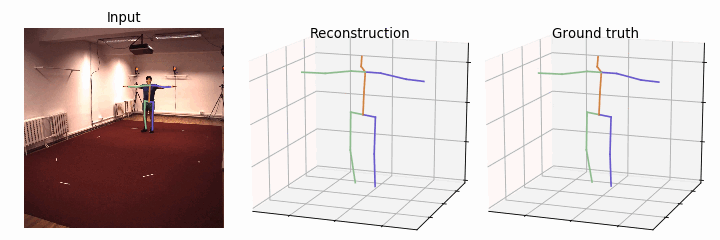Improving Robustness and Accuracy via Relative Information Encoding in 3D Human Pose Estimation (ACM MM2021)
Make sure you have the following dependencies installed:
- PyTorch >= 0.4.0
- NumPy
- Matplotlib=3.1.0
- FFmpeg (if you want to export MP4 videos)
- ImageMagick (if you want to export GIFs)
Our model is evaluated on Human3.6M and HumanEva-I datasets. We set up the Human3.6M dataset in the same way as VideoPose3D. You can download the processed data from here. data_2d_h36m_gt.npz is the ground truth of 2D keypoints. data_2d_h36m_cpn_ft_h36m_dbb.npz is the 2D keypoints obatined by CPN. data_3d_h36m.npz is the ground truth of 3D human joints. Put them in the ./data directory.
You can download our pretrained models from here. Put cpn_pretrained.bin and gt_pretrained.bin in the ./checkpoint directory. Both of the models are trained on Human3.6M dataset.
To evaluate the model trained on the ground truth of 2D keypoints, run:
python run.py -k gt --evaluate gt_pretrained.bin --stage 3 -lfd 256 -lfd stands for "latent feature dimension". It controls the dimension of the latent features (including local features, global features, and fused features).
To evaluate the model trained on the 2D keypoints obtained by CPN, run:
python run.py -k cpn_ft_h36m_dbb --evaluate cpn_pretrained.bin --stage 3 -lfd 512 It is more difficult to estimate 3D poses from the 2D keypoint detector (such as CPN). Therefore, we use more parameters in cpn_pretrained.bin than in gt_pretrained.bin. We set the dimension of the latent features to 512.
To train a model using the proposed multi-stage optimization method, you can run the following commands step by step.
For the first stage, run:
python run.py -k gt --stage 1 -lfd 256 This will train the encoders for 80 epochs. In this stage, the Feature Fusion Module (FFM) does not participate in the optimization process.
For the second stage, run:
python run.py -k gt --stage 2 -lfd 256 -p stage_1_epoch_80.binThis will train the FFM for 80 epochs. The parameters of the encoders are loaded from the first stage and fixed.
For the third stage, run:
python run.py -k gt --stage 3 -lfd 256 -r stage_2_epoch_80.bin -lr 0.0005 This will finetune the whole framework for 20 epochs.
To generate visualizations of the model, run:
-k gt --evaluate gt_pretrained.bin --stage 3 -lfd 256 --render --viz-subject S11 --viz-action WalkDog --viz-camera 1 --viz-video "./s_11_act_15_subact_02_ca_02.mp4" --viz-output output.gif --viz-size 3 --viz-downsample 2 --viz-limit 300You can get different results by changing the values of these arguments.
If you find this repo useful, please consider cite our paper:
@article{shan2021improving,
title={Improving Robustness and Accuracy via Relative Information Encoding in 3D Human Pose Estimation},
author={Shan, Wenkang and Lu, Haopeng and Wang, Shanshe and Zhang, Xinfeng and Gao, Wen},
journal={arXiv preprint arXiv:2107.13994},
year={2021}
}
Our code refers to the following repositories.
We thank the authors for releasing their codes. If you use our code, please consider citing their works as well.



